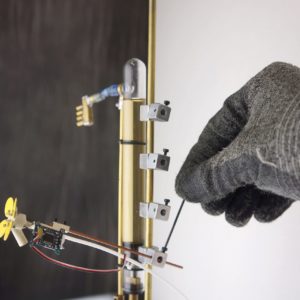As we carry on with our busy lives each day, it is all too easy to step on an ant or a bee, or to swat one out of our line of vision — and just keep on moving without a thought. You may get a big surprise if you step on one barefoot or for some reason attract the dreaded sting, but otherwise you may not put much thought into the complexities of their miniature lives, or the systems they create. The degree to which bees are important to our ecosystem is staggering though; and in fact, the peril to their populations around the world has motivated researchers to continue studying them in greater detail, along with giving us ongoing information about why we should not only appreciate bees but encourage their propagation.
Michael Candy, an artist from Brisbane, Australia, is striving to do his part for bees in creating 3D printed robotic flowers for pollination. This is not the first combination we’ve seen between 3D printing and bees, having previously followed innovations such as 3D printed honeycomb and even collaborative art with bees; however, the Synthetic Pollenizer is highly unique and could prove to be important to the survival of bees.
Candy’s Synthetic Pollenizer is so effective, it is actually safer for bees than other plants and flowers. These flowers of the future hold both pollen and nectar, and Candy made them to be placed outside in the midst of normal greenery, drawing bees.
Candy used the rapeseed species as inspiration, and each of the 3D printed flowers within his innovative system has an artificial stamen. He used a special device to trap actual pollen from a bee hive—collecting the fluid as it fell from bees’ hind legs.
“Bees are a vital part of our ecosystem, I feel that everyone needs to take the time and get to know these hard workers that keep our plants and crops pollinated,” Candy recently told Dezeen.
“It is common knowledge that bee population is suffering worldwide due to pesticides, climate change and Varroa mites – for these problems we can find solutions.”
Success with the project has not happened overnight by any means though, as bees are not that easy to fool. Candy had to work for several years to get bees to land on his creations, as they have a strong sense of color and form in relation to plant life. To attract bees, he created an intricate system, thrusting nectar upward via motors and tubes.
“Bees are easily the most utilitarian pollinators used in industrial agriculture and they are suffering from a variety of environmental problems,” said Candy. “Perhaps in a future where designer crops are no longer able to produce pollen yet still receive it – then the Synthetic Pollenizer could rehabilitate the reproductive cycle of these genetically modified crops.”
Check out a live stream for the Synthetic Pollenizer here.
Discuss this article and other 3D printing topics at 3DPrintBoard.com.
[Source/Images: DeZeen]
Subscribe to Our Email Newsletter
Stay up-to-date on all the latest news from the 3D printing industry and receive information and offers from third party vendors.
You May Also Like
$25M to Back Sintavia’s Largest Expansion of Metal 3D Printing Capacity Since 2019
Sintavia, the digital manufacturing company specializing in mission-critical parts for strategic sectors, announced a $25 million investment to increase its production capacity, the largest expansion to its operations since 2019....
Velo3D Initiates Public Offering in a Bid to Strengthen Financial Foundations and Drive Future Growth
Velo3D (NYSE: VLD) has been among a number of publicly traded 3D printing firms that have attempted to weather the current macroeconomic climate. After posting a challenging financial report for 2023,...
Micronics to Offer $2,999 SLS 3D Printer—Is it Real?
A startup called Micronics has recently unveiled a desktop powder bed fusion system priced at a mere $2,999. The team highlights the inclusion of its proprietary slicing software and the...
3DPOD Episode 193: Flow and What’s Possible in 3D Printing with Ricky Wildman, University of Nottingham
Ricky Wildman is working on 3D printing pills, but, as Professor of Multiphase Flow and Physics at Nottingham, he does a whole lot more. His research encompasses the characterization of...


































